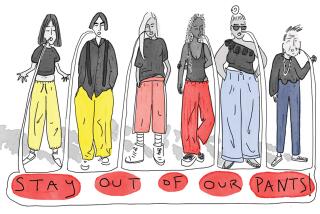That’s why they’re called ‘bathing’ suits
- Share via
The idea of the modern-day swimsuit has been around for a while — just check out the 4th century bathing bellas in bikini-like bandeaus and bottoms frolicking along the mosaic tiles on the floor of Sicily’s Villa Romana del Casale. But, like everything else in fashion, we had to wait for them to come back in style again, which they did less than 150 years ago after centuries during which people swam nude or in their underwear — if they swam at all. With the help of Kevin Jones, curator of the Fashion Institute of Design and Merchandising’s Museum Collection, and author Sarah Kennedy, (“Vintage Swimwear,” Sterling Publishing, $34.95) we take a look at some of swimwear’s more noteworthy moments since fussy Victorian women donned woollen water-wear to bathe — not swim.
Late 1880s: While young men might swim au naturel, revolutionary young women begin to head to the water’s edge with just about every inch of skin covered, for it is not fitting to be tan. Their wool bathing costumes have long sleeves and high necks, not to mention stockings, long pantaloons and a skirt that at least grazes the knee. The outfits are accessorized with bathing caps and parasols. Cotton material slowly takes over as sleeves get shorter around 1910.
1907: Australian swimmer and film star Annette Kellerman causes a scandal in Boston by wearing a one-piece bathing suit in public. She’s arrested for indecent exposure.
1913: Jantzen, “the suit that changed bathing to swimming,” makes rib-stitch uniforms for Oregon’s Portland Rowing Club. They sell the bathing suit in their catalog in 1915, with their “Red Diving Girl” logo of a pretty thing in a red suit, stockings and cap appearing in 1920.
1920s: Designers such as Coco Chanel and Jean Patou popularize resort wear (think beach pajama cover ups for walking on the board walk) as the suntan begins to signify a life of excess and leisure instead of one that requires manual labor. Patou is the first designer to put his logo on swimwear, officially making the bathing suit a designer garment.
1936: Hollywood costume designer Margit Fellegi partners with Cole of California to bring the bathing suit stylings of Hollywood “It” girls like Esther Williams to their adoring female fans.
1943: Betty Grable poses in a one-piece for photographer Frank Powolny, creating an image that will be pinned up in military bunkers around Europe and the Pacific through the rest of World War II.
1946: Burlesque dancer Micheline Bernardini shows off her belly button in Louis Réard’s skimpy two-piece made of cloth with newspaper print at the Paris swimming pool Piscine Molitor. Réard names his creation after nuclear test site Bikini Atoll — fittingly, as the design creates a shock heard round the world.
1953: French sex kitten Brigitte Bardot causes a media sensation when she wears a bikini to the Cannes Film Festival.
1964: Sports Illustrated launches its first swimsuit edition, featuring model Babette March in a white bikini.
1964: Photographs of model Peggy Moffitt in Rudi Gernreich’s topless monokini appear in Women’s Wear Daily and Life magazine. The shocking design is actually what children of both genders wear for swimming in Gernreich’s home of Austria. That same year, Margit Fellegi and Cole of California launch the Scandal swimsuit, which is modestly cut if you don’t count the mesh netting inserts.
1974: As the natural look in fashion takes over and Europe’s nude beach idea lands on U.S. soil, racy Rudi Gernreich returns with his new invention, the thong bikini, which is launched with a “media event” at the home of celeb hair stylist Vidal Sassoon.
1976: Speedo becomes the official swimwear licensed for the Montreal Olympics.
1980s: Due to the aerobics craze, neon color block designs continue from the ubiquitous Jazzercise classes to the beach, and the rubbery neoprene fabric used by surfers is a hit.
1985: The tankini, a two-piece bathing ensemble made of a tank top and bikini bottom, enters the Merriam-Webster lexicon — and continues to gain ground up into the late 1990s.
1996: Beach volleyball is an official Olympic sport and female participants are required to wear two-piece uniforms.
2000: Olympic athletes in Sydney show off Arena’s Powerskin, which is lighter and absorbs less water than average suits, and Speedo unveils the performance-enhancing Fastskin suit they claim replicates shark’s skin.
2006: Molly Sims wears a $30-million diamond bikini for Sports Illustrated’s Swimsuit Issue — judging by the size of the suit, we’re guessing they weren’t charging by the yard.
2009: FINA, the International Swimming Federation, bans full-body performance-enhancing suits like the Speedo LZR Racer — which gold medalist Michael Phelps wore at the 2008 Beijing Olympics. The organization rules that, for competitive events, men’s suits can extend only from knee to waist and women’s suits from shoulder to knee.
2010: Alpine ski racer Lindsey Vonn makes headlines for winning an Olympic gold medal in Vancouver — and for posing in a bikini and fur hat for Sports Ilustrated.






